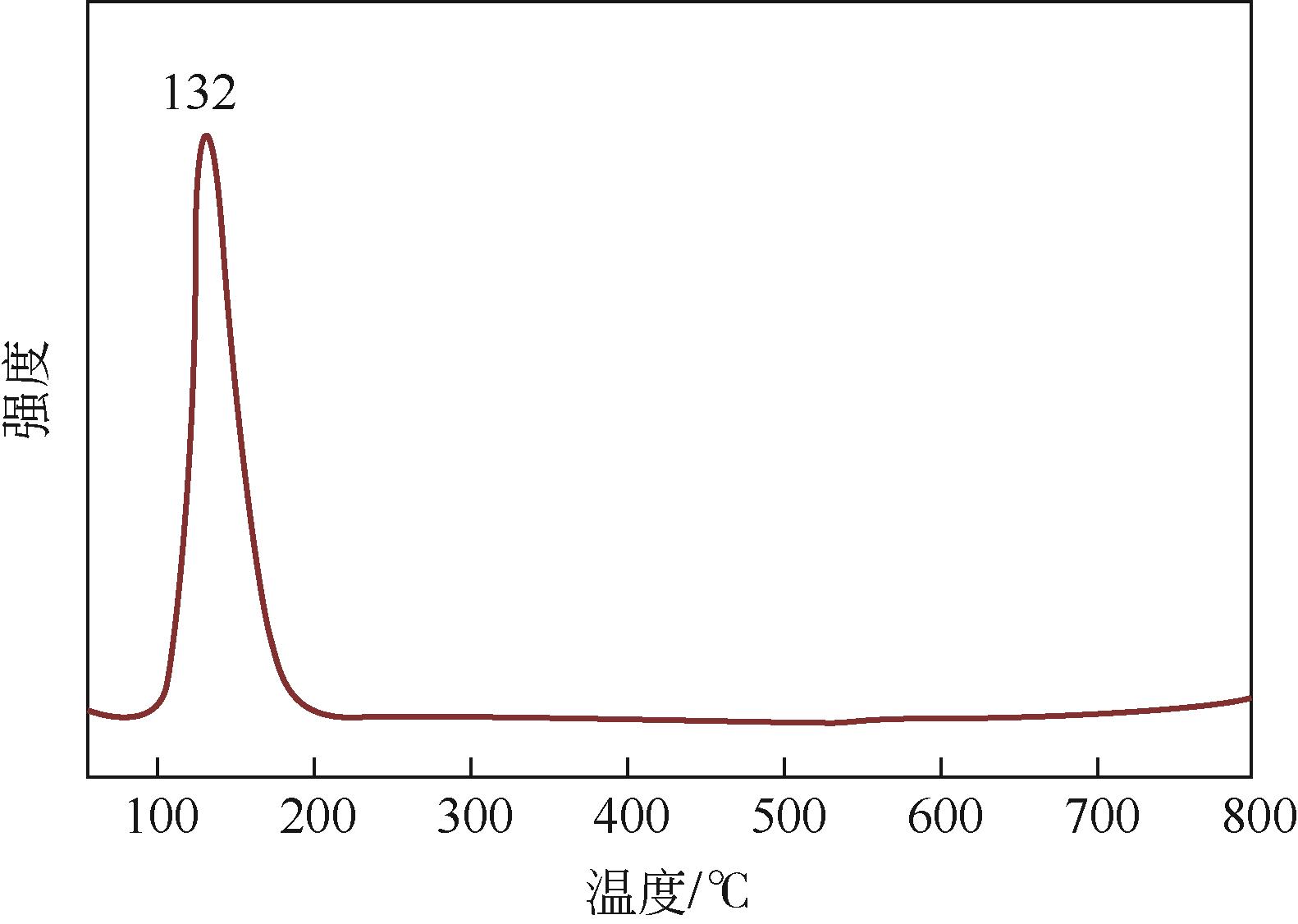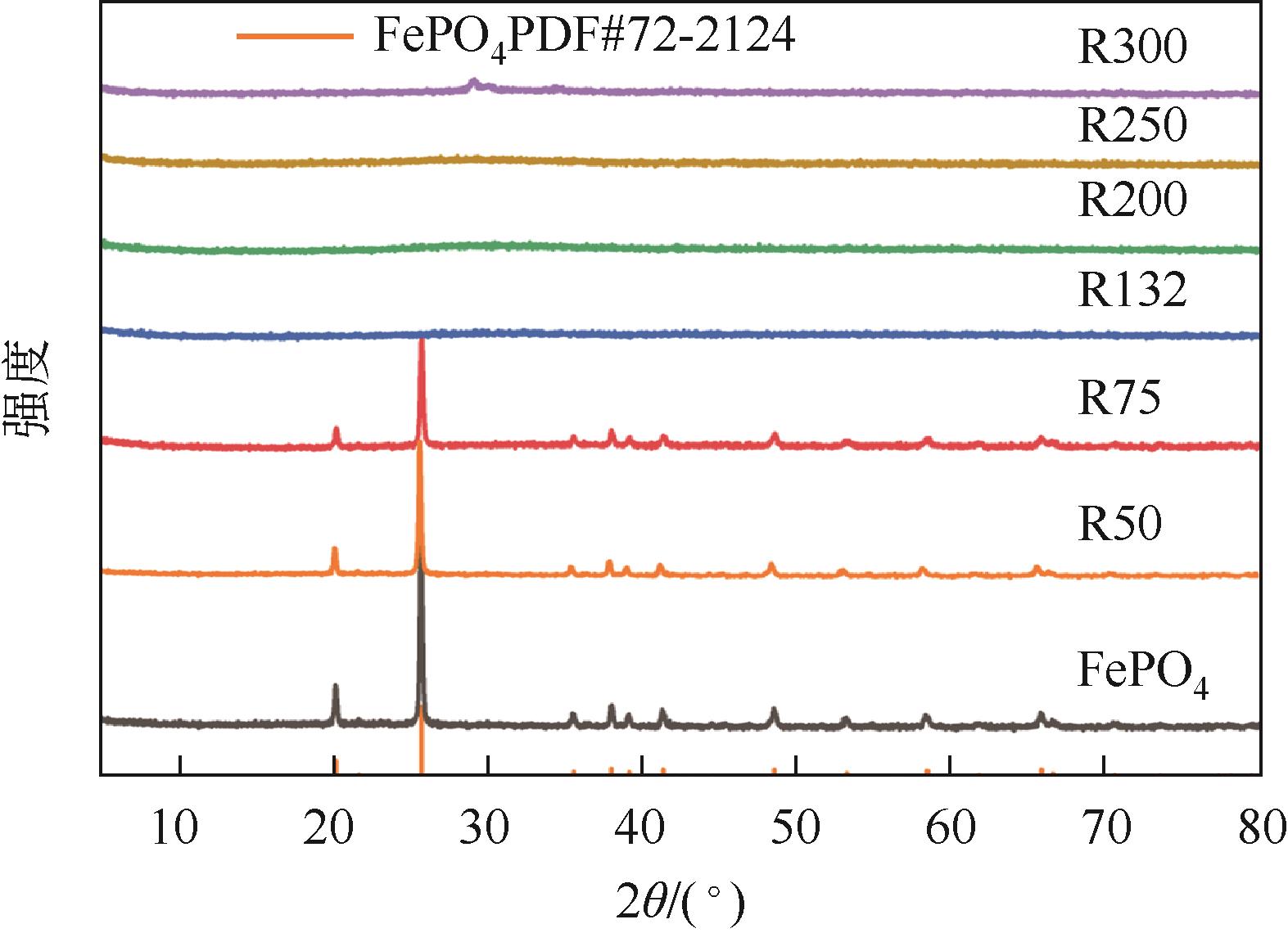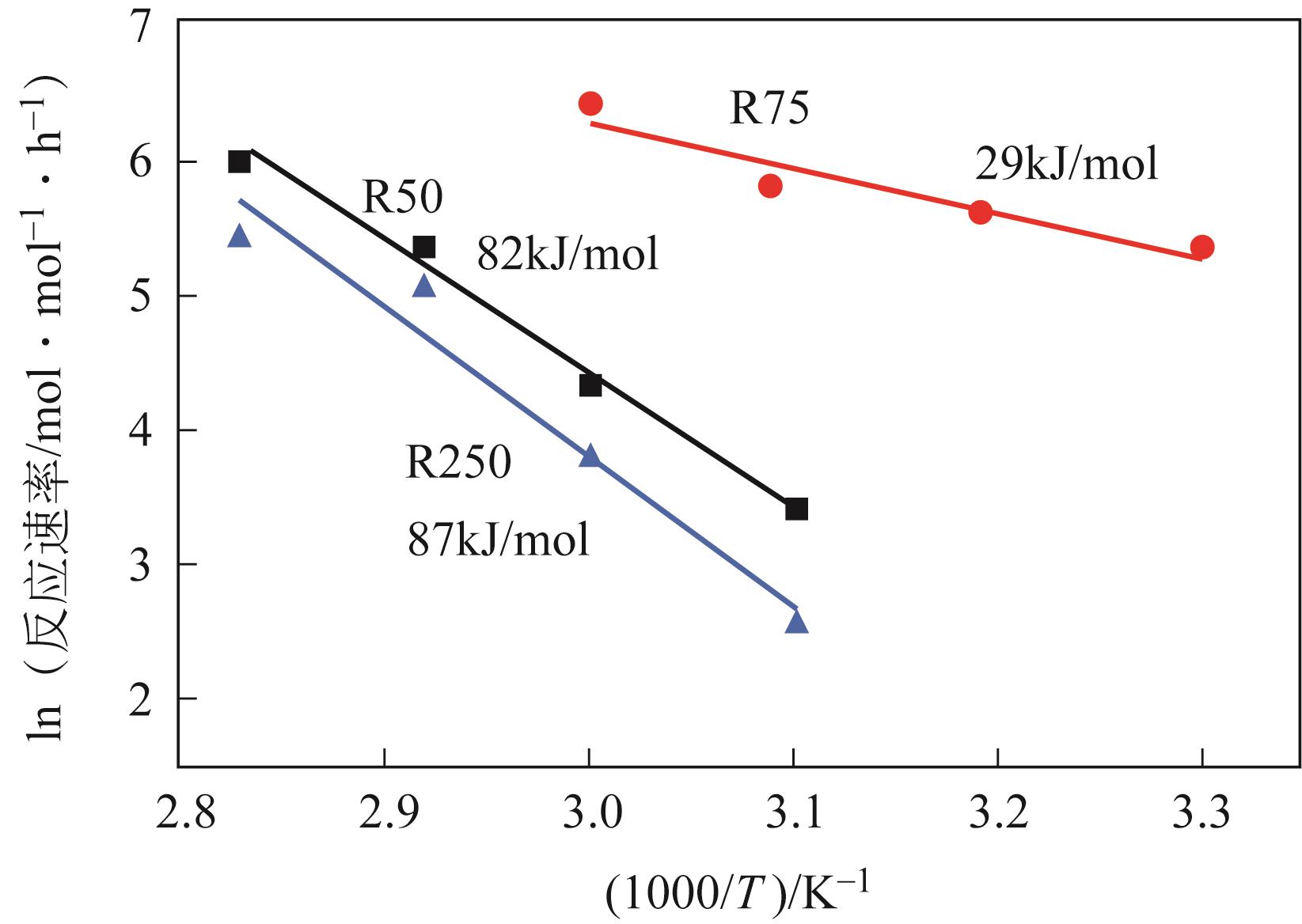Chemical Industry and Engineering Progress ›› 2024, Vol. 43 ›› Issue (3): 1342-1349.DOI: 10.16085/j.issn.1000-6613.2023-1394
• Industrial catalysis • Previous Articles
Tuning the catalytic performance of Rh/FePO4 catalyst by reduction temperature for quinoline selective hydrogenation
LI Kairui( ), GAO Zhaohua, LIU Tiantian, LI Jing, WEI Haisheng(
), GAO Zhaohua, LIU Tiantian, LI Jing, WEI Haisheng( )
)
- College of Chemistry and Chemical Engineering, Yantai University, Yantai 264005, Shandong, China
-
Received:2023-08-11Revised:2023-12-22Online:2024-04-11Published:2024-03-10 -
Contact:WEI Haisheng
还原温度调变Rh/FePO4催化剂喹啉选择加氢性能
- 烟台大学化学化工学院,山东 烟台 264005
-
通讯作者:魏海生 -
作者简介:李开瑞(1995—),男,硕士研究生,研究方向为工业催化。E-mail:18437963239@163.com。 -
基金资助:国家自然科学基金(21808193);烟台市科技创新发展计划(2021XDHZ069)
CLC Number:
Cite this article
LI Kairui, GAO Zhaohua, LIU Tiantian, LI Jing, WEI Haisheng. Tuning the catalytic performance of Rh/FePO4 catalyst by reduction temperature for quinoline selective hydrogenation[J]. Chemical Industry and Engineering Progress, 2024, 43(3): 1342-1349.
李开瑞, 高照华, 刘甜甜, 李静, 魏海生. 还原温度调变Rh/FePO4催化剂喹啉选择加氢性能[J]. 化工进展, 2024, 43(3): 1342-1349.
share this article
Add to citation manager EndNote|Ris|BibTeX
URL: https://hgjz.cip.com.cn/EN/10.16085/j.issn.1000-6613.2023-1394
| 催化剂 | 转化率/% | 选择性/% | 反应速率/mol·mol-1·h-1 | TOF/h-1 | ||
|---|---|---|---|---|---|---|
| 1,2,3,4-四氢喹啉 | 5,6,7,8-四氢喹啉 | 十氢喹啉 | ||||
| Rh/FePO4-未还原 | — | — | — | — | — | — |
| Rh/FePO4-R50 | 15.6 | >99 | 0 | 0 | 30 | — |
| Rh/FePO4-R75 | 98.5 | >99 | 0 | 0 | 353 | 353 |
| Rh/FePO4-R132 | 80.6 | >99 | 0 | 0 | 161 | — |
| Rh/FePO4-R200 | 36.1 | >99 | 0 | 0 | 79 | — |
| Rh/FePO4-R250 | 11.2 | >99 | 0 | 0 | 22 | 34 |
| Rh/FePO4-R300 | 5.1 | >99 | 0 | 0 | 10 | — |
| 催化剂 | 转化率/% | 选择性/% | 反应速率/mol·mol-1·h-1 | TOF/h-1 | ||
|---|---|---|---|---|---|---|
| 1,2,3,4-四氢喹啉 | 5,6,7,8-四氢喹啉 | 十氢喹啉 | ||||
| Rh/FePO4-未还原 | — | — | — | — | — | — |
| Rh/FePO4-R50 | 15.6 | >99 | 0 | 0 | 30 | — |
| Rh/FePO4-R75 | 98.5 | >99 | 0 | 0 | 353 | 353 |
| Rh/FePO4-R132 | 80.6 | >99 | 0 | 0 | 161 | — |
| Rh/FePO4-R200 | 36.1 | >99 | 0 | 0 | 79 | — |
| Rh/FePO4-R250 | 11.2 | >99 | 0 | 0 | 22 | 34 |
| Rh/FePO4-R300 | 5.1 | >99 | 0 | 0 | 10 | — |
| 催化剂 | Rh3+ | Rh δ+ | Rh0 |
|---|---|---|---|
| Rh/FePO4-R50 | 100% | 0 | 0 |
| Rh/FePO4-R75 | 80.4% | 7.5% | 12.1% |
| Rh/FePO4-R250 | 22.3% | 24.3% | 53.4% |
| 催化剂 | Rh3+ | Rh δ+ | Rh0 |
|---|---|---|---|
| Rh/FePO4-R50 | 100% | 0 | 0 |
| Rh/FePO4-R75 | 80.4% | 7.5% | 12.1% |
| Rh/FePO4-R250 | 22.3% | 24.3% | 53.4% |
| 16 | XU Ruibo, CHAKRABORTY Sumit, YUAN Hongmei, et al. Acceptorless, reversible dehydrogenation and hydrogenation of N-heterocycles with a cobalt pincer catalyst[J]. ACS Catalysis, 2015, 5(11): 6350-6354. |
| 17 | GONG Yutong, ZHANG Pengfei, XU Xuan, et al. A novel catalyst Pd@OMPG-C3N4 for highly chemoselective hydrogenation of quinoline under mild conditions[J]. Journal of Catalysis, 2013, 297: 272-280. |
| 18 | BECKERS Nicole A, HUYNH Steven, ZHANG Xiaojiang, et al. Screening of heterogeneous multimetallic nanoparticle catalysts supported on metal oxides for mono-, poly-, and heteroaromatic hydrogenation activity[J]. ACS Catalysis, 2012, 2(8): 1524-1534. |
| 19 | CHANDRA Debraj, SAINI Shikha, BHATTACHARYA Saswata, et al. Electronic effect in a ruthenium catalyst designed in nanoporous N-functionalized carbon for efficient hydrogenation of heteroarenes[J]. ACS Applied Materials & Interfaces, 2020, 12(47): 52668-52677. |
| 20 | DERAEDT Christophe, YE Rong, RALSTON Walter T, et al. Dendrimer-stabilized metal nanoparticles as efficient catalysts for reversible dehydrogenation/hydrogenation of N-heterocycles[J]. Journal of the American Chemical Society, 2017, 139(49): 18084-18092. |
| 21 | KAR Ashish Kumar,, SRIVASTAVA Rajendra. Solvent-dependent, formic acid-mediated, selective reduction and reductive N-formylation of N-heterocyclic arenes with sustainable cobalt-embedded N-doped porous carbon catalyst[J]. ACS Sustainable Chemistry & Engineering, 2019, 7(15): 13136-13147. |
| 22 | ZHAO Jianbo, YUAN Haifeng, QIN Xiaomei, et al. Au nanoparticles confined in SBA-15 as a highly efficient and stable catalyst for hydrogenation of quinoline to 1,2,3,4-tetrahydroquinoline[J]. Catalysis Letters, 2020, 150(10): 2841-2849. |
| 23 | WEI Zhongzhe, SHAO Fangjun, WANG Jianguo. Recent advances in heterogeneous catalytic hydrogenation and dehydrogenation of N-heterocycles[J]. Chinese Journal of Catalysis, 2019, 40(7): 980-1002. |
| 24 | BAI Licheng, WANG Xin, CHEN Qiang, et al. Explaining the size dependence in platinum-nanoparticle-catalyzed hydrogenation reactions[J]. Angewandte Chemie International Edition, 2016, 55(50): 15656-15661. |
| 25 | MILLER Jeremie J, SIGMAN Matthew S. Quantitatively correlating the effect of ligand-substituent size in asymmetric catalysis using linear free energy relationships[J]. Angewandte Chemie International Edition, 2008, 47(4): 771-774. |
| 26 | JIANG Heyan, ZHENG Xuxu. Phosphine-functionalized ionic liquid-stabilized rhodium nanoparticles for selective hydrogenation of aromatic compounds[J]. Applied Catalysis A: General, 2015, 499: 118-123. |
| 27 | MUNEYAMA E, KUNISHIGE A, OHDAN K, et al. Reduction and reoxidation of iron phosphate and its catalytic activity for oxidative dehydrogenation of isobutyric acid[J]. Journal of Catalysis, 1996, 158(2): 378-384. |
| 28 | BERGERET G, GALLEZOT P. Handbook of heretogeneous catalysis[M]. 2008, 2, 738-765. |
| 1 | TAN Khai Chen, YU Yang, CHEN Ruting, et al. Metallo-N-heterocycles—A new family of hydrogen storage material[J]. Energy Storage Materials, 2020, 26: 198-202. |
| 2 | WEI Fang, WANG Weiguo, MA Yudao, et al. Regioselective synthesis of multisubstituted 1,2,3-triazoles: Moving beyond the copper-catalyzed azide-alkyne cycloaddition[J]. Chemical Communications, 2016, 52(99): 14188-14199. |
| 3 | YAMAGUCHI Ryohei, IKEDA Chikako, TAKAHASHI Yoshinori, et al. Homogeneous catalytic system for reversible dehydrogenation-hydrogenation reactions of nitrogen heterocycles with reversible interconversion of catalytic species[J]. Journal of the American Chemical Society, 2009, 131(24): 8410-8412. |
| 4 | ZHANG Fengwei, MA Chunlan, CHEN Shuai, et al. N-doped hierarchical porous carbon anchored tiny Pd NPs: A mild and efficient quinolines selective hydrogenation catalyst[J]. Molecular Catalysis, 2018, 452: 145-153. |
| 5 | Rafik OMAR-AMRANI, THOMAS Antoine, BRENNER Eric, et al. Efficient nickel-mediated intramolecular amination of aryl chlorides[J]. Organic Letters, 2003, 5, 5(13): 2311-2314. |
| 6 | YAMAMOTO Hisashi, MARUOKA Keiji. Selective reactions using organoaluminum reagents[M]. Current Trends in Organic Synthesis. Amsterdam: Elsevier, 1983: 281-289. |
| 7 | HAKKI Amer, DILLERT Ralf, BAHNEMANN Detlef W. Arenesulfonic acid-functionalized mesoporous silica decorated with titania: A heterogeneous catalyst for the one-pot photocatalytic synthesis of quinolines from nitroaromatic compounds and alcohols[J]. ACS Catalysis, 2013, 3(4): 565-572. |
| 8 | ALVARADO Ysaı́as, BUSOLO Marı́a, Francisco LÓPEZ-LINARES. Regioselective homogeneous hydrogenation of quinoline by use of pyrazolyl borate ligand and transition metal complexes as a precatalyst[J]. Journal of Molecular Catalysis A: Chemical, 1999, 142(2): 163-167. |
| 9 | ROSALES Merlín, BASTIDAS Luis Jhonatan, Beatriz GONZÁLEZ, et al. Kinetics and mechanisms of homogeneous catalytic reactions. Part 11. Regioselective hydrogenation of quinoline catalyzed by rhodium systems containing 1,2-bis(diphenylphosphino) ethane[J]. Catalysis Letters, 2011, 141(9): 1305-1310. |
| 10 | LU Shengmei, HAN Xiuwen, ZHOU Yonggui. An efficient catalytic system for the hydrogenation of quinolines[J]. Journal of Organometallic Chemistry, 2007, 692(14): 3065-3069. |
| 11 | WANG Zhijian, ZHOU Haifeng, WANG Tianli, et al. Highly enantioselective hydrogenation of quinolines under solvent-free or highly concentrated conditions[J]. Green Chemistry, 2009, 11(6): 767-769. |
| 12 | ZHOU Yonggui. Asymmetric hydrogenation of heteroaromatic compounds[J]. Accounts of Chemical Research, 2007, 40(12): 1357-1366. |
| 13 | DOBEREINER Graham E, NOVA Ainara, SCHLEY Nathan D, et al. Iridium-catalyzed hydrogenation of N-heterocyclic compounds under mild conditions by an outer-sphere pathway[J]. Journal of the American Chemical Society, 2011, 133(19): 7547-7562. |
| 14 | XU Conghui, ZHANG Lingjuan, DONG Chaonan, et al. Iridium-catalyzed transfer hydrogenation of 1,10-phenanthrolines using formic acid as the hydrogen source[J]. Advanced Synthesis & Catalysis, 2016, 358(4): 567-572. |
| 15 | TU Xifeng, GONG Liuzhu. Highly enantioselective transfer hydrogenation of quinolines catalyzed by gold phosphates: Achiral ligand tuning and chiral-anion control of stereoselectivity[J]. Angewandte Chemie International Edition, 2012, 51(45): 11346-11349. |
| 29 | BARAN E J, BOTTO I L, NORD A G. The vibrational spectrum and the conformation of the P2O4-7 anion in Fe2P2O7 [J]. Journal of Molecular Structure, 1986, 143: 151-154. |
| 30 | SONG Yanning, YANG Shoufeng, ZAVALIJ Peter Y, et al. Temperature-dependent properties of FePO4 cathode materials[J]. Materials Research Bulletin, 2002, 37(7): 1249-1257. |
| 31 | GADGIL M M, KULSHRESHTHA S K. Study of FePO4 catalyst[J]. Journal of Solid State Chemistry, 1994, 111(2): 357-364. |
| 32 | ULASEVICH Sviatlana A, BREZESINSKI Gerald, MOHWALD Helmuth, et al. Light-induced water splitting causes high-amplitude oscillation of pH-sensitive layer-by-layer assemblies on TiO2 [J]. Angewandte Chemie International Edition, 2016, 55(42): 13001-13004. |
| 33 | Zara WENG-SIEH, GRONSKY Ronald, BELL Alexis T. Microstructural evolution of γ-alumina-supported Rh upon aging in air[J]. Journal of Catalysis, 1997, 170(1): 62-74. |
| 34 | JANAMPELLI Sagar, DARBHA Srinivas. Metal oxide-promoted hydrodeoxygenation activity of platinum in Pt-MO x /Al2O3 catalysts for green diesel production[J]. Energy & Fuels, 2018, 32(12): 12630-12643. |
| [1] | LIU Fangwang, HAN Yi, ZHANG Jiajia, BU Honghong, WANG Xingpeng, YU Chuanfeng, LIU Mengshuai. Research advance of heterogeneous catalytic system for the coupling between CO2 and epoxide into propylene carbonate [J]. Chemical Industry and Engineering Progress, 2024, 43(3): 1252-1265. |
| [2] |
ZHANG Pengfei, YAN Zhangyan, REN Liang, ZHAGN Kui, LIANG Jialin, ZHAO Guangle, ZHANG Fanbin, HU Zhihai.
Research progress in the catalytic hydrodealkylation of C |
| [3] | GU Xingpeng, MA Hongqin, LIU Jiahao. Modification of Rainey nickel with phosphorus quantum dots and its catalytic hydrodesulfurization performances [J]. Chemical Industry and Engineering Progress, 2024, 43(3): 1293-1301. |
| [4] | ZHANG Shuming, LIU Huazhang. Optimization of Fe1-x O ammonia synthesis catalyst by BP neural network model [J]. Chemical Industry and Engineering Progress, 2024, 43(3): 1302-1308. |
| [5] | XIAO Yaoxin, ZHANG Jun, SHAN Rui, YUAN Haoran, CHEN Yong. Catalytic hydrogenation of furfuryl alcohol into pentanediol over Pt/CaO materials [J]. Chemical Industry and Engineering Progress, 2024, 43(3): 1318-1327. |
| [6] | LI Weijie, KANG Jincan, ZHANG Chuanming, LIN Lina, LI Changxin, ZHU Hongping. Selective hydrogenation of methyl 3-hydroxypropionate over zirconium-modified Cu/SiO2 catalysts [J]. Chemical Industry and Engineering Progress, 2024, 43(3): 1328-1341. |
| [7] | LOU Rui, NIU Taoyuan, CAO Qihang, ZHANG Yiyi, LEI Wenqi, LU Congmin, WANG Zhiwei. Preparation and electrochemical performances of in-situ growth of δ-MnO2 on hierarchical porous carbon derived from LNP [J]. Chemical Industry and Engineering Progress, 2024, 43(2): 1013-1021. |
| [8] | JU Fang. Fabrication and properties of synergistic antibacterial hydrogels based on the silver-sulfur coordination [J]. Chemical Industry and Engineering Progress, 2024, 43(2): 1039-1046. |
| [9] | CHEN Xiaozhen, LIU Li, YANG Chengmin, ZHENG Bumei, YIN Xiaoying, SUN Jin, YAO Yunhai, DUAN Weiyu. Research progress of alumina-supported hydrodesulfurization catalyst [J]. Chemical Industry and Engineering Progress, 2024, 43(2): 948-961. |
| [10] | DING Kang, HE Junqiao, CHEN Yuanjie, YANG Xiazhen, LIU Huazhang, HUO Chao. Effect of hydrochloric acid treatment on catalytic performance of Ru/Ba-MgO catalyst template cotton fiber [J]. Chemical Industry and Engineering Progress, 2024, 43(2): 962-970. |
| [11] | WANG Darui, SUN Hongmin, WANG Yiyan, TANG Zhimou, LI Rui, FAN Xueyan, YANG Weimin. Recent progress in zeolite for efficient catalytic reaction process [J]. Chemical Industry and Engineering Progress, 2024, 43(1): 1-18. |
| [12] | SU Mengjun, LIU Jian, XIN Jing, CHEN Yufei, ZHANG Haihong, HAN Longnian, ZHU Yuanbao, LI Hongbao. Progress in the application of gas-liquid mixing intensification in fixed-bed hydrogenation [J]. Chemical Industry and Engineering Progress, 2024, 43(1): 100-110. |
| [13] | CHEN Yaoji, REN Chengyu, HU Daqing, LU Hanfeng, GE Chunliang, CUI Guokai. Carbon monoxide conversion via ionic liquids intensification [J]. Chemical Industry and Engineering Progress, 2024, 43(1): 124-134. |
| [14] | LUO Fen, YANG Xiaoqi, DUAN Fanglin, LI Xiaojiang, WU Liang, XU Tongwen. Recent advances in the bipolar membrane and its applications [J]. Chemical Industry and Engineering Progress, 2024, 43(1): 145-163. |
| [15] | GAI Hongwei, ZHANG Chenjun, QU Jingying, SUN Huailu, TUO Yongxiao, WANG Bin, JIN Xu, ZHANG Xi, FENG Xiang, CHEN De. Research progress on catalytic dehydrogenation process intensification for liquid organic hydride carrier hydrogen storage [J]. Chemical Industry and Engineering Progress, 2024, 43(1): 164-185. |
| Viewed | ||||||
|
Full text |
|
|||||
|
Abstract |
|
|||||






